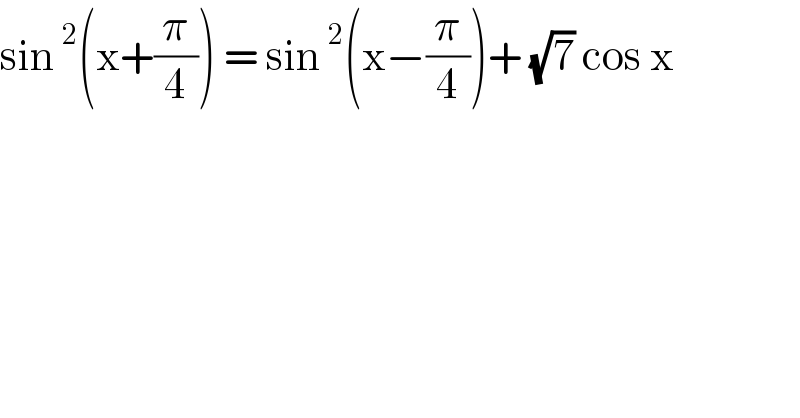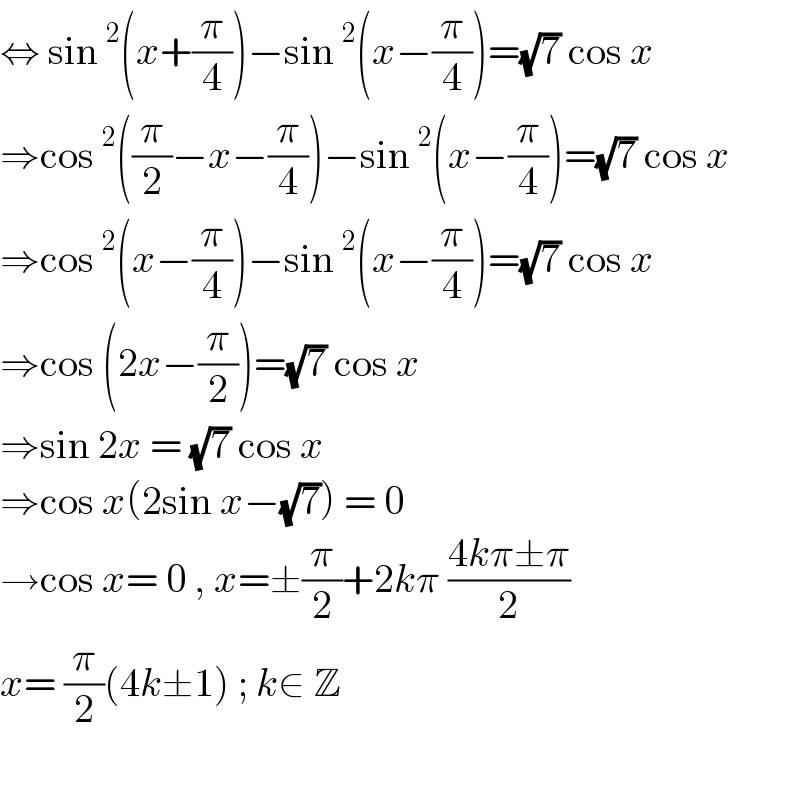
Question Number 135497 by EDWIN88 last updated on 13/Mar/21

$$\mathrm{sin}\:^{\mathrm{2}} \left(\mathrm{x}+\frac{\pi}{\mathrm{4}}\right)\:=\:\mathrm{sin}\:^{\mathrm{2}} \left(\mathrm{x}−\frac{\pi}{\mathrm{4}}\right)+\:\sqrt{\mathrm{7}}\:\mathrm{cos}\:\mathrm{x} \\ $$
Answered by john_santu last updated on 13/Mar/21

$$\Leftrightarrow\:\mathrm{sin}\:^{\mathrm{2}} \left({x}+\frac{\pi}{\mathrm{4}}\right)−\mathrm{sin}\:^{\mathrm{2}} \left({x}−\frac{\pi}{\mathrm{4}}\right)=\sqrt{\mathrm{7}}\:\mathrm{cos}\:{x} \\ $$$$\Rightarrow\mathrm{cos}\:^{\mathrm{2}} \left(\frac{\pi}{\mathrm{2}}−{x}−\frac{\pi}{\mathrm{4}}\right)−\mathrm{sin}\:^{\mathrm{2}} \left({x}−\frac{\pi}{\mathrm{4}}\right)=\sqrt{\mathrm{7}}\:\mathrm{cos}\:{x} \\ $$$$\Rightarrow\mathrm{cos}\:^{\mathrm{2}} \left({x}−\frac{\pi}{\mathrm{4}}\right)−\mathrm{sin}\:^{\mathrm{2}} \left({x}−\frac{\pi}{\mathrm{4}}\right)=\sqrt{\mathrm{7}}\:\mathrm{cos}\:{x} \\ $$$$\Rightarrow\mathrm{cos}\:\left(\mathrm{2}{x}−\frac{\pi}{\mathrm{2}}\right)=\sqrt{\mathrm{7}}\:\mathrm{cos}\:{x} \\ $$$$\Rightarrow\mathrm{sin}\:\mathrm{2}{x}\:=\:\sqrt{\mathrm{7}}\:\mathrm{cos}\:{x} \\ $$$$\Rightarrow\mathrm{cos}\:{x}\left(\mathrm{2sin}\:{x}−\sqrt{\mathrm{7}}\right)\:=\:\mathrm{0} \\ $$$$\rightarrow\mathrm{cos}\:{x}=\:\mathrm{0}\:,\:{x}=\pm\frac{\pi}{\mathrm{2}}+\mathrm{2}{k}\pi\:\frac{\mathrm{4}{k}\pi\pm\pi}{\mathrm{2}} \\ $$$${x}=\:\frac{\pi}{\mathrm{2}}\left(\mathrm{4}{k}\pm\mathrm{1}\right)\:;\:{k}\in\:\mathbb{Z} \\ $$$$ \\ $$
Answered by mathmax by abdo last updated on 13/Mar/21

$$\mathrm{e}\Rightarrow\frac{\mathrm{1}−\mathrm{cos}\left(\mathrm{2x}+\frac{\pi}{\mathrm{2}}\right)}{\mathrm{2}}−\frac{\mathrm{1}−\mathrm{cos}\left(\mathrm{2x}−\frac{\pi}{\mathrm{2}}\right)}{\mathrm{2}}−\sqrt{\mathrm{7}}\mathrm{cosx}\:=\mathrm{0}\:\Rightarrow \\ $$$$\mathrm{1}+\mathrm{sin}\left(\mathrm{2x}\right)−\mathrm{1}+\mathrm{sin}\left(\mathrm{2x}\right)−\mathrm{2}\sqrt{\mathrm{7}}\mathrm{cosx}\:=\mathrm{0}\:\Rightarrow \\ $$$$\mathrm{2sin}\left(\mathrm{2x}\right)−\mathrm{2}\sqrt{\mathrm{7}}\mathrm{cosx}\:=\mathrm{0}\:\Rightarrow\mathrm{sin}\left(\mathrm{2x}\right)−\sqrt{\mathrm{7}}\mathrm{cosx}\:=\mathrm{0}\:\Rightarrow \\ $$$$\mathrm{2sinx}\:\mathrm{cosx}−\sqrt{\mathrm{7}}\mathrm{cosx}\:=\mathrm{0}\:\Rightarrow\mathrm{cosx}\left(\mathrm{2sinx}−\sqrt{\mathrm{7}}\right)\:=\mathrm{0}\:\Rightarrow\mathrm{cosx}=\mathrm{0}\:\mathrm{or} \\ $$$$\mathrm{2sinx}\:=\sqrt{\mathrm{7}} \\ $$$$\mathrm{cosx}\:=\mathrm{0}\:\Rightarrow\mathrm{x}\:=\overset{−} {+}\frac{\pi}{\mathrm{2}}+\mathrm{k}\pi\:\:\:\mathrm{and}\:\:\mathrm{sinx}\:=\frac{\sqrt{\mathrm{7}}}{\mathrm{2}}\:\mathrm{is}\:\mathrm{impossible}\:\mathrm{due}\:\mathrm{to}\:\frac{\sqrt{\mathrm{7}}}{\mathrm{2}}>\mathrm{1} \\ $$
